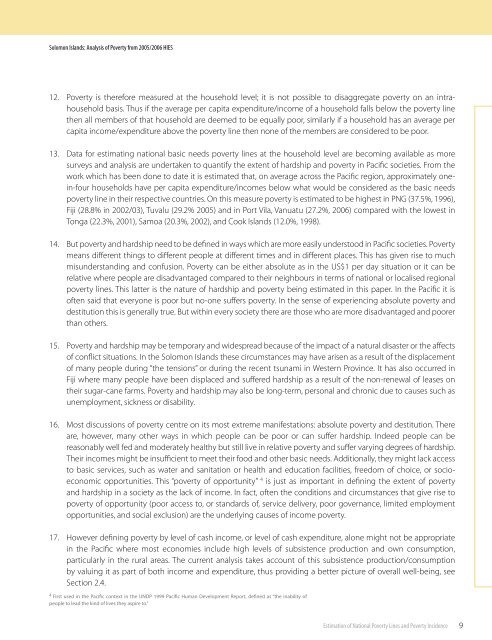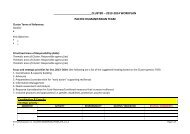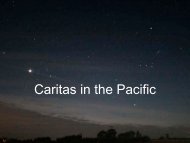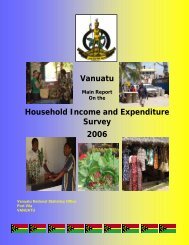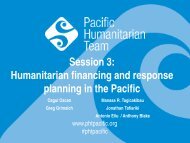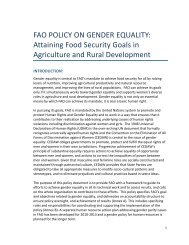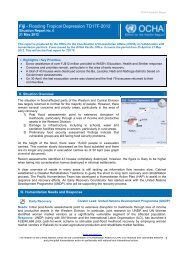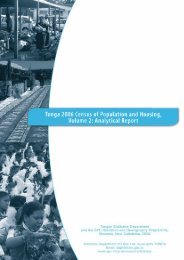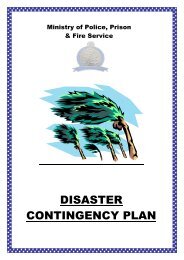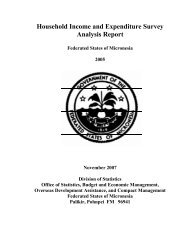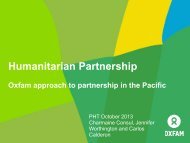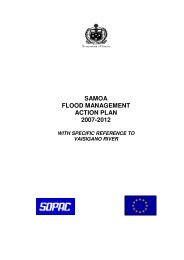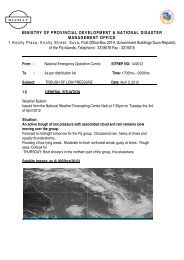Solomon Islands - Asia & the Pacific
Solomon Islands - Asia & the Pacific
Solomon Islands - Asia & the Pacific
You also want an ePaper? Increase the reach of your titles
YUMPU automatically turns print PDFs into web optimized ePapers that Google loves.
<strong>Solomon</strong> <strong>Islands</strong>: Analysis of Poverty from 2005/2006 HIES12. Poverty is <strong>the</strong>refore measured at <strong>the</strong> household level; it is not possible to disaggregate poverty on an intrahouseholdbasis. Thus if <strong>the</strong> average per capita expenditure/income of a household falls below <strong>the</strong> poverty line<strong>the</strong>n all members of that household are deemed to be equally poor, similarly if a household has an average percapita income/expenditure above <strong>the</strong> poverty line <strong>the</strong>n none of <strong>the</strong> members are considered to be poor.13. Data for estimating national basic needs poverty lines at <strong>the</strong> household level are becoming available as moresurveys and analysis are undertaken to quantify <strong>the</strong> extent of hardship and poverty in <strong>Pacific</strong> societies. From <strong>the</strong>work which has been done to date it is estimated that, on average across <strong>the</strong> <strong>Pacific</strong> region, approximately onein-fourhouseholds have per capita expenditure/incomes below what would be considered as <strong>the</strong> basic needspoverty line in <strong>the</strong>ir respective countries. On this measure poverty is estimated to be highest in PNG (37.5%, 1996),Fiji (28.8% in 2002/03), Tuvalu (29.2% 2005) and in Port Vila, Vanuatu (27.2%, 2006) compared with <strong>the</strong> lowest inTonga (22.3%, 2001), Samoa (20.3%, 2002), and Cook <strong>Islands</strong> (12.0%, 1998).14. But poverty and hardship need to be defined in ways which are more easily understood in <strong>Pacific</strong> societies. Povertymeans different things to different people at different times and in different places. This has given rise to muchmisunderstanding and confusion. Poverty can be ei<strong>the</strong>r absolute as in <strong>the</strong> US$1 per day situation or it can berelative where people are disadvantaged compared to <strong>the</strong>ir neighbours in terms of national or localised regionalpoverty lines. This latter is <strong>the</strong> nature of hardship and poverty being estimated in this paper. In <strong>the</strong> <strong>Pacific</strong> it isoften said that everyone is poor but no-one suffers poverty. In <strong>the</strong> sense of experiencing absolute poverty anddestitution this is generally true. But within every society <strong>the</strong>re are those who are more disadvantaged and poorerthan o<strong>the</strong>rs.15. Poverty and hardship may be temporary and widespread because of <strong>the</strong> impact of a natural disaster or <strong>the</strong> affectsof conflict situations. In <strong>the</strong> <strong>Solomon</strong> <strong>Islands</strong> <strong>the</strong>se circumstances may have arisen as a result of <strong>the</strong> displacementof many people during “<strong>the</strong> tensions” or during <strong>the</strong> recent tsunami in Western Province. It has also occurred inFiji where many people have been displaced and suffered hardship as a result of <strong>the</strong> non-renewal of leases on<strong>the</strong>ir sugar-cane farms. Poverty and hardship may also be long-term, personal and chronic due to causes such asunemployment, sickness or disability.16. Most discussions of poverty centre on its most extreme manifestations: absolute poverty and destitution. Thereare, however, many o<strong>the</strong>r ways in which people can be poor or can suffer hardship. Indeed people can bereasonably well fed and moderately healthy but still live in relative poverty and suffer varying degrees of hardship.Their incomes might be insufficient to meet <strong>the</strong>ir food and o<strong>the</strong>r basic needs. Additionally, <strong>the</strong>y might lack accessto basic services, such as water and sanitation or health and education facilities, freedom of choice, or socioeconomicopportunities. This “poverty of opportunity” 4 is just as important in defining <strong>the</strong> extent of povertyand hardship in a society as <strong>the</strong> lack of income. In fact, often <strong>the</strong> conditions and circumstances that give rise topoverty of opportunity (poor access to, or standards of, service delivery, poor governance, limited employmentopportunities, and social exclusion) are <strong>the</strong> underlying causes of income poverty.17. However defining poverty by level of cash income, or level of cash expenditure, alone might not be appropriatein <strong>the</strong> <strong>Pacific</strong> where most economies include high levels of subsistence production and own consumption,particularly in <strong>the</strong> rural areas. The current analysis takes account of this subsistence production/consumptionby valuing it as part of both income and expenditure, thus providing a better picture of overall well-being, seeSection 2.4.4 First used in <strong>the</strong> <strong>Pacific</strong> context in <strong>the</strong> UNDP 1999 <strong>Pacific</strong> Human Development Report, defined as “<strong>the</strong> inability ofpeople to lead <strong>the</strong> kind of lives <strong>the</strong>y aspire to.”Estimation of National Poverty Lines and Poverty Incidence


